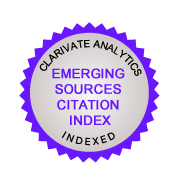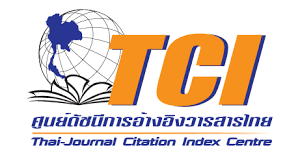Effects of poly(butylene succinate) and calcium carbonate on the physical properties of plasticized poly(vinyl chloride)
Keywords:
Poly(vinyl chloride), Diisononyl phthalate, Poly(butylene succinate), Calcium carbonate, Physical propertiesAbstract
In this studypoly(butylene succinate) (PBS) , a polymeric plasticizer, was partially replaced a conventional plasticizer, diisononyl phthalate (DINP) to avoid the plasticizer loss from poly(vinyl chloride) (PVC) overtime for various service conditions and to obtain a long-term plasticizer retention in the flexible PVC products. The plasticized PVC samples were prepared by melt mixing on a two roll mill, followed by compression molding. The mechanical properties (tensile properties, tear strength and hardness), thermal stability and morphology of the 20/20 phr (parts by weight per hundred parts of resin) DINP/PBS-plasticized PVC were evaluated and compared with those of the 40 phr DINP-plasticized PVC. The tensile strength, Young’s modulus, tear strength, hardness and thermal stability were found to be improved, while the elongation at break was decreased as a result of the partial replacement of DINP with PBS in the plasticized PVC. Moreover, the DINP/PBS-plasticized PVC composites filled with varied loadings of CaCO3 (2.5, 5, 7.5 and 10 phr) showed an increase in the elongation at break, Young’s modulus and thermal stability in a dose-dependent manner, while the tensile strength, tear strength and hardness were unaffected by the increasing amount of CaCO3. The morphology of the composites observed by scanning electron microscopy showed a number of voids on the fractured surface of the plasticized PVC due to the pulling out CaCO3 particles, caused by the low interfacial adhesion between filler and polymer.
Downloads
References
Marathe, D.S. and Joshi, P.S. (2009). Characterization of highly filled wood flour-PVC composites: morphological and thermal studies. J. Appl. Polym. Sci. 114(1) : 90-96.
Shah, B.L. and Shertukde, V.V. (2003). Effect of plasticizers on mechanical, electrical, permanence, and thermal properties of poly(vinyl chloride). J. Appl. Polym. Sci. 90(12) : 3278-3284.
Das, G. and Karak, N. (2012). Epoxidized Mesua ferrea L. seed oil-plasticized thermostable PVC and PVC-clay nanocomposites. J. Vinyl Addit. Technol. 18(3) : 168-177.
Garcia-Quesada, J.C., Pelaez, I., Akin, O. and Kocabas, I. (2012). Processability of PVC plastisols containing a polyhydroxybutyratepolyhydroxyvalerate copolymer. J. Vinyl Addit. Technol. 18(1) : 9-16.
Pielichowski, K. and Świerz-Motysia, B. (2006). Influence of polyesterurethane plasticizer on the kinetics of poly(vinyl chloride) decomposition process. J. Therm. Anal. Cal. 83(1) : 207-212.
Pena, J.R., Hidalgo, M. and Mijangos, C. (2000). Plastification of poly(vinyl chloride) by polymer blending. J. Appl. Polym. Sci. 75(10) : 1303-1312.
Li, X., Xiao, Y., Wang, B., Tang, Y., Lu, Y. and Wang, C. (2012). Effects of poly(1,2-propylene glycol adipate) and nano-CaCO3 on DOP migration and mechanical properties of flexible PVC. J. Appl. Polym. Sci. 124(2) : 1737-1743.
Ambrogi, V., Brostow, W., Carfagna, C., Pannico, M. and Persico, P. (2012). Plasticizer migration from cross-linked flexible PVC : Effects on tribology and hardness. Polym. Eng. Sci. 52(1) : 211-217.
Tüzüm Demir, A.P. and Ulutan, S. (2013). Migration of phthalate and non-phthalate plasticizers out of plasticized PVC films into air. J. Appl. Polym. Sci. 128(3) : 1948-1961.
Li, H., Wang, L., Song, G., Gu, Z.H., Li, P., Zhang, C.H. and Gao, L. (2010). Study of NBR/PVC/OMMT nanocomposites prepared by mechanical blending. Iran. Polym. J. 19(1) : 39-46.
Sunny, M.C., Ramesh, P. and George, K.E. (2004). Use of polymeric plasticizers in polyvinyl chloride to reduce conventional plasticizer migration for critical applications. J. Elastom. Plast. 36(1) : 19-31.
Ha, C.S., Kim, Y., Lee, W.K., Cho, W.J. and Kim, Y. (1998). Fracture toughness and properties of plasticized PVC and thermoplastic polyurethane blends. Polymer. 39(20) : 4765-4772.
Pita, V.J.R.R., Sampaio, E.E.M. and Monteiro, E.E.C. (2002). Mechanical properties evaluation of PVC/plasticizers and PVC/thermoplastic polyurethane blends from extrusion processing. Polym. Test. 21(5) : 545-550.
Deanin, R.D. and Zheng-Bai, Z. (1984). Polycaprolactone as a permanent plasticizer for pol(vinyl chloride). J. Vinyl Addit. Technol. 6(1) : 18-21.
Rusu, M., Ursu, M. and Rusu, D. (2006). Poly(vinyl chloride) and poly(ε-caprolactone) blends for medical use. J. Thermoplast. Compos. Mater. 19(2) : 173-190.
Rahim, M.N.M., Ibrahim, N.A., Sharif, J. and Wan Yunus, W.M.Z. (2010). Mechanical and thermal properties of poly(vinyl chloride) /poly(butylene adipateco-terephthalate) clay nanocomposites. J. Reinf. Plast. Compos. 29(21) : 3219-3225.
Ratnam, C.T. and Zaman, K. (1999). Stabilization of poly (vinyl chloride)/epoxidized natural rubber (PVC/ENR) blends. Polym. Degrad. Stabil. 65(1) : 99-105.
Thomas, N.L. (2004). Alloying of poly(vinyl chloride) to reduce plasticizer migration. J. Appl. Polym. Sci. 94(5) : 2022-2031.
Kim, H.S., Lee, B.H., Lee, S., Kim, H.J. and Dorgan, J.R. (2011). Enhanced interfacial adhesion, mechanical, and thermal properties of natural flour-filled biodegradable polymer bio-composites. J. Therm. Anal. Calorim. 104(1) : 331-338.
Zhiu, J., Wang, X., Hua, K., Duan, C., Zhang, W., Ji, J. and Yang, X. (2013). Enhanced mechanical properties and degradability of poly(butylene succinate) and poly(lactic acid) blends. Iran. Polym. J. 22(4) : 267-275.
Kanemura, C., Nakashima, S. and Hotta, A. (2012). Mechanical properties and chemical structures of biodegradable poly(butylene -succinate) for material reprocessing. Polym. Degrad. Stabil. 97(6) : 972-980.
Ahamad, A., Patil, C.B., Gite, V.V. and Hundiwale, D.G. (2012). Evaluation of the synergistic effect of layered double hydroxides with micro-and nano-CaCO3 on the thermal stability of polyvinyl chloride composites. J. Thermoplast. Compos. Mater. 26(9) : 1249-1259.
Sombatsompop, N., Teptim, K., Chaochanchaikul, K., Thongpin, C. and Rosarpitak, V. (2008). Improvement of structural and thermal stabilities of PVC and wood/PVC composite by Zn and Pb stearates and zeolite. J. Macromol. Sci. Pure Appl. Chem. 45(7) : 534-541.
Sajjadi Jazi, S.H., Nasr Esfahany, M. and Bagheri, R. (2012). Investigation of the addition of nano-CaCo3 at dry mixing or onset of fusion on the dispersion, torque, and mechanical properties of compounded PVC. J. Vinyl Addit. Technol. 18(3) : 153-160.
Downloads
Published
How to Cite
Issue
Section
License
Copyright (c) 2014 Journal of Metals, Materials and Minerals

This work is licensed under a Creative Commons Attribution-NonCommercial-NoDerivatives 4.0 International License.
Authors who publish in this journal agree to the following terms:
- Authors retain copyright and grant the journal right of first publication with the work simultaneously licensed under a Creative Commons Attribution License that allows others to share the work with an acknowledgment of the work's authorship and initial publication in this journal.
- Authors are able to enter into separate, additional contractual arrangements for the non-exclusive distribution of the journal's published version of the work (e.g., post it to an institutional repository or publish it in a book), with an acknowledgment of its initial publication in this journal.








